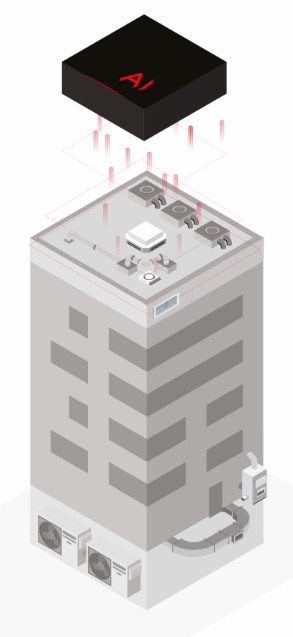March 6, 2020 – A Montreal, Quebec-based company is using artificial intelligence (AI) to study installed heating and air conditioning (HVAC) systems to reduce greenhouse gas (GHG) emissions from building infrastructure. In an interview with Jean-Simon Venne, Chief Technology Officer and Co-Founder of the company who since May 2019 has been managing almost 1.7 million square meters (18,000,000 square feet) of commercial buildings, in 15 plus locations, he and I talked about the implications of managing HVAC systems for the planet’s climate.
BrainBox AI is a black box external device that connects to the HVAC control system in a building to monitor its internal environmental conditions throughout. Initially, it begins studying thousands of real-time data points generated by the HVAC controller. After 6 to 8 weeks it can then take over managing temperature and humidity controls throughout autonomously.
BrainBox AI is offered to clients in a software-as-a-service (SaaS) model with cost savings on energy use providing a return on investment in 90 days.
The BrainBox AI uses deep learning, a form of AI that can learn from unstructured or unlabeled data. It is a form of machine learning that employs neural network characteristics similar to the way our human brain thinks. Learning to recognize patterns within unstructured data is something humans can do well. Think of our sensory inputs and how we process what we see, taste, smell, and touch. Deep learning algorithms are designed to parse data inputs of this type, building layers upon layers of data inputs to create a picture or model that becomes increasingly clear and detailed over time.
I asked Jean-Simon a number of questions as we talked about the challenges of using deep learning to optimize HVAC performance in all kinds of building environments from deserts to the extreme cold and heat of climates like those we endure in Canada. Getting a building in all of its areas to not be too cold, not be too hot, just right, is the proverbial Goldilocks challenge.
1. What needs to be in place in a building’s infrastructure for Brainbox AI to work?
BrainBox AI connects to the HVAC control system of any commercial building whether it be a glass tower, warehouse, manufacturing facility, or shopping mall. A typical HVAC system for an entire building generates lots of data. For example, a million square foot building will continuously generate 40,000 data points in real-time.
Look at Miami Airport. This is a big facility generating 160,000 data points each with a data value that BrainBox AI reads and sends to the Cloud where it is kept. This is data that normally would be lost because HVAC systems tend not to store data values continuously overwriting them every few seconds.
But BrainBox AI doesn’t limit its data gathering to the internal HVAC data points. The technology looks at external details such as weather conditions and even the weather forecast allowing the system to be pre-emptive in managing a building’s heating and cooling.
2. Can Brainbox AI work with buildings that have a mix of HVAC controls such as independent unit thermostats?
In asking this question I was thinking of the condominium where my wife and I live with a centralized HVAC system but individual apartment analog temperature control units disconnected from it. This is what Jean-Simon said.
There are at least a dozen smart thermostats on the market today that can be installed in individual units of an apartment or condominium allowing them to be linked to provide BrainBox AI with the data these devices generate. But unless these thermostats are IoT devices that can be linked to BrainBox AI, it can only monitor and manage the common areas within a structure.
Most condominiums and apartment owners don’t realize that changing analog thermostats to Internet-of-Thing (IoT) devices which are rapidly getting less expensive, can immediately pay dividends. Building management and condominium boards can identify where there are heating and cooling challenges not just within the common elements but in individual units, identifying energy hogs, or owners and tenants managing energy usage effectively. In most of these types of multi-residential buildings, this is likely to lead to some pretty interesting conversations.
So the potential for deployment in residential buildings is there, but resistance to change remains an impediment to deployment.
3. What’s involved to install BrainBox AI?
Every building has a control room for its heating and air conditioning. BrainBox AI simply externally attaches to the HVAC control system. At 30 centimeters square (12″x12″) it is a simple install that immediately begins to collect the thousands of data points created by the HVAC system to build a picture of the building’s internal environmental characteristics.
4. How does BrainBox AI handle different types of buildings in different climates?
BrainBox AI’s deep learning algorithm requires a minimum quantity of data to achieve 99.6% accuracy before a building can be managed autonomously regardless of location. In some locations, getting up to speed takes longer because more extreme weather and temperature shifts require a longer period for the AI to discern seasonal pattern changes. That’s not the case for a building in Miami, but very much the case for a building in Edmonton, or Montreal where temperature extremes go from mid-30 Celsius (90 Fahrenheit) in the summer to minus 40 Celsius (the same in Fahrenheit) in winter.
5. Where is BrainBox AI deployed today?
The current focus of the company is on commercial buildings including schools, office towers, hospitals, malls, airport terminals, manufacturing facilities, and warehousing operations. The company’s installed base includes buildings in Montreal, Toronto, Calgary, Edmonton, Ireland, New Jersey, Florida, and a shopping mall in Sydney, Australia which this year because of the extreme heat and bushfires has been particularly challenging and a good test of deep learning’s capabilities.
6. How have you calculated the carbon footprint reduction statistics quoted on your website?
We state on our website that adopters of our technology see energy reduction savings and a capital expenditure (CAPEX) payback within 3 months. The energy saved whether it be in cubic meters of natural gas or kilowatt-hours of electricity represent the benchmarks for determining a 20 to 40% decrease in the average building’s carbon footprint.
7. What is the importance of being nominated for the Edison Award?
We are thrilled to have been named a finalist in the category of Smart Building Solutions for the 2020 Edison Awards, an industry-insider award judged by 3,000 industry peers who honour product innovation. Of the three finalists named in the smart building solutions category, ours is the only AI autonomous management solution. The winning announcement is in April, but being in the final three is pretty exciting for a company whose first commercial install only happened in 2019.
8. Can BrainBox AI anticipate changing conditions in a building over time?
The system can track data trends, noting deviations from normal HVAC operations. But BrainBox AI cannot pinpoint the cause. It can, however, monitor the results of a change such as replacing windows and then seeing if energy savings follow. In this sense, it can help building managers match performance guarantees from building material suppliers against actual results.
Before I ended the call with Jean-Simon I asked him what’s on the horizon. We talked about changes in energy distribution systems from the grid to local off-grid or building cluster power solutions. He said to me, “That’s something we’re looking at with swarm AI for multiple buildings representing a new stage for BrainBox AI.” He promised to keep me posted on its development and I, of course, will let you, my readers in on what could be a powerful tool for mitigating climate change through better environmental management of building infrastructure.









